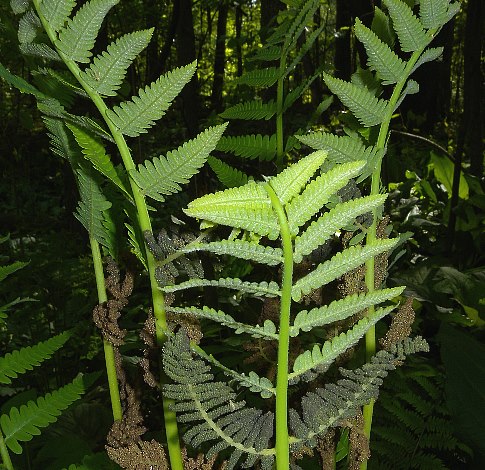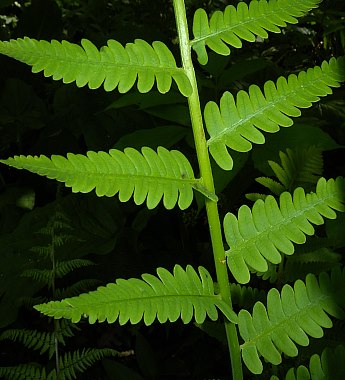Description: This perennial fern develops a rosette of ascending to nearly erect leaves about 2-4' tall. In outline, each blade is elliptic-oblong in shape, while its structure is pinnate-pinnatifid, consisting of 20 or more pairs of leaflets. The leaflets are longest toward the middle of each leaf (if they are sterile), becoming smaller toward both the top and the bottom. The pinnatifid leaflets are deeply lobed and narrowly lanceolate. There are 10 or more pairs of lobes per leaflet; the lobes become gradually smaller toward the tip of each leaflet. The lobes are broadly oblong and smooth to slightly undulate along their margins; their tips are usually well-rounded. The lateral veins on the lobe undersides are forked. The upper surface of the leaves is medium green and glabrous, while the lower surface is pale green. The rachis (central stalk) of each leaf is light green and terete. The petioles are mostly terete and lack scales; they are about one-third as long as the blades of the leaves. During the spring, rachis, petiole, and underside of fertile leaves are covered with white- or brown-woolly hairs; later they become glabrous or nearly so. At this time, fertile leaves also have 2-7 pairs of leaflets toward the middle that are densely covered with sporangia (spore-bearing structures). These middle leaflets are black or brown from the sporangia and somewhat constricted or contorted in appearance. The tiny globoid sporangia release their spores through narrow openings during the spring or summer. Infertile leaves that lack sporangia are also produced; they are more glabrous overall and their middle leaflets have a normal appearance. The root system is fibrous and rhizomatous; vegetative offsets are occasionally produced from the rhizomes. The leaves of this fern are deciduous and they die down during the autumn.

Cultivation:
This
fern prefers dappled sunlight to light shade, moist to mesic
conditions, and a slightly acidic soil containing loam or sandy loam
with abundant organic material. It also adapts to shallow rocky soil.
Adequate humidity and some protection from prevailing winds are
required.
Range & Habitat:
The native Interrupted Fern is uncommon to occasional in northern and
west-central Illinois, while in the remaining areas of the state it is
rare or absent (see Distribution
Map). Habitats include sandy woodlands, openings in sandy
woodlands, drier areas of swamps, rocky or sandy wooded slopes,
sandstone ledges along ravines, and shaded sandy areas along small
lakes or streams.
Faunal Associations:
The caterpillars of Papaipema speciosissima
(Osmunda Borer Moth) and Olethreutes osmundana
(Tortricid Moth sp.) feed on Interrupted Fern and other Osmunda
spp. Because the foliage of this fern is bitter and probably
toxic, it is rarely eaten by mammalian herbivores. The large leaves
provide cover for ground-nesting birds and other animals, particularly
when large colonies of plants are formed.

Photographic
Location:
A sandy wooded area near a small lake at the Oak Openings Nature
Preserve in NW Ohio.
Comments:
When the fertile leaflets are conspicuous during the spring, they
provide this fern with an unusual appearance – almost like it is
afflicted with some kind of disease. Later, these leaflets wither away,
leaving a gap (or 'interruption') between the upper and the lower
leaflets on each fertile leaf. When only infertile leaves are present,
they are difficult to distinguish from the infertile leaves of Cinnamon
Fern (Osmunda cinnamomea). Generally, the petioles
of Cinnamon Fern are more brown-woolly than those of Interrupted Fern,
especially later in the year, when the latter fern becomes hairless (or
nearly so). The leaflets of Cinnamon Fern have persistent tufts of
woolly hair at their bases along the rachis, while the leaflets of
Interrupted Fern are usually glabrous at their bases from the summer
onward. Instead of restricting its sporangia toward the middle of its
fertile leaves, Cinnamon Fern produces reddish brown fertile leaves
that are covered entirely by sporangia from top to bottom.